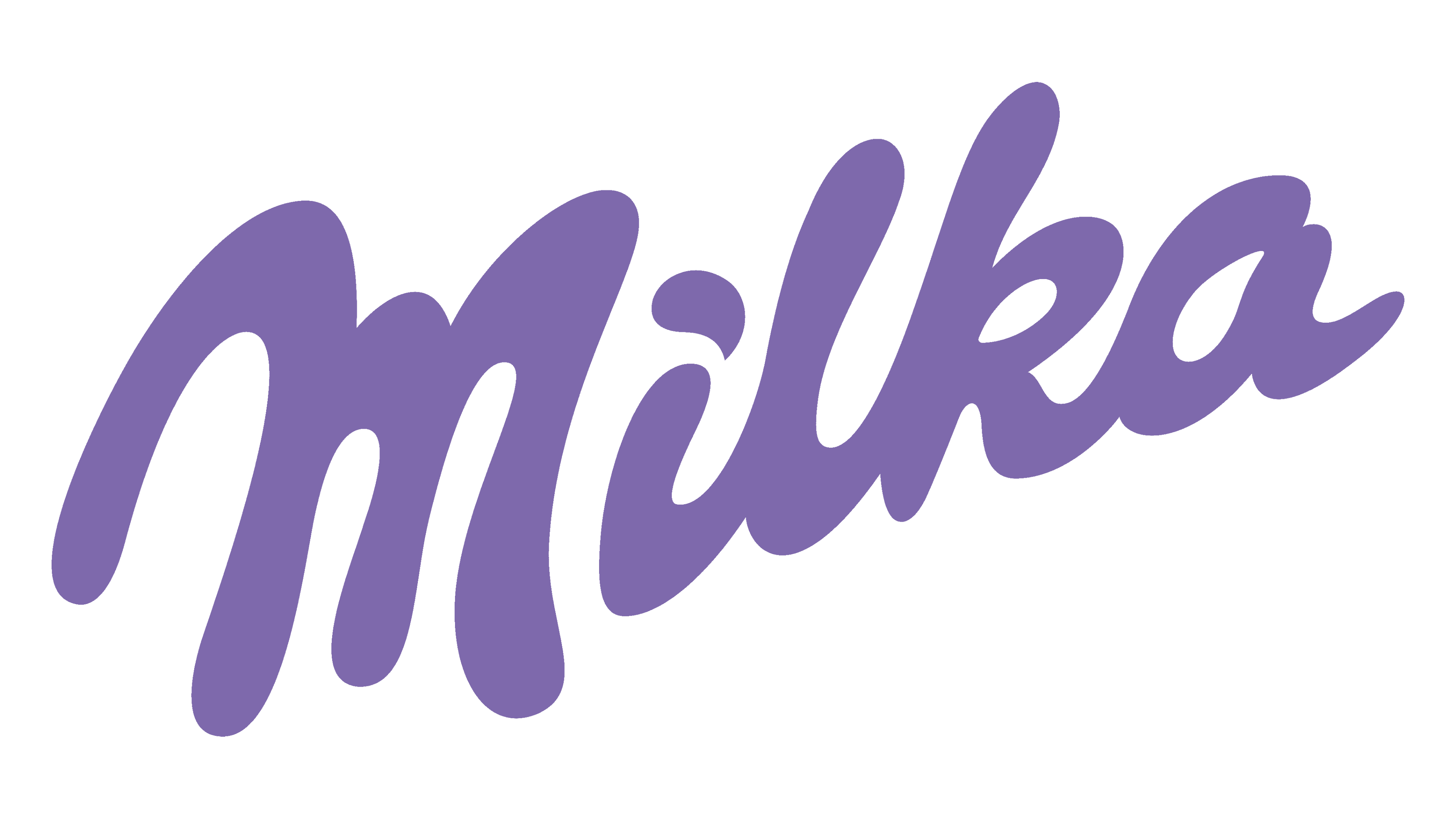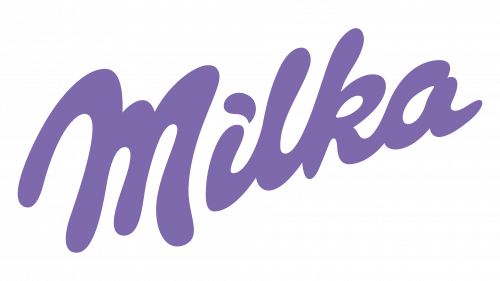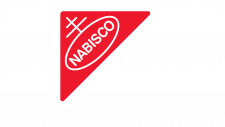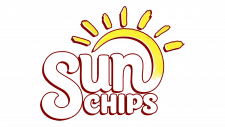Milka Logo
Milka is a prominent chocolate brand renowned for its signature purple packaging and the Alpine milk used in its products. Originating in Switzerland, Milka has become a symbol of indulgent, high-quality chocolate. The brand, now a subsidiary of Mondelēz International, operates extensively in Europe and has been expanding globally. Known for its range of chocolate bars, Milka also offers confectionery like biscuits and seasonal treats. Its main markets include Germany, France, and Eastern Europe, where the brand is synonymous with creamy, smooth chocolate. Mondelēz International’s ownership has enabled Milka to leverage extensive distribution networks, enhancing its global presence.
Meaning and history
Milka’s origin dates back to 1901 in Switzerland, under the auspices of the Suchard Company. Famed for its milk chocolate, Milka’s recipe uniquely incorporated Alpine milk, a characteristic that has become synonymous with the brand. The name “Milka” itself is a clever blend of the German words for ‘milk’ and ‘cocoa.’
The brand’s evolution over the 20th century included a broadening of its product line, making it a household name in regions like Switzerland and Germany. The 1960s brought a distinct touch with the introduction of the now-iconic lilac packaging, further setting Milka apart in the competitive chocolate market.
Milka’s ownership journey witnessed pivotal changes. A significant milestone was in 1990, with the merger of the Suchard Company and Jacobs coffee, creating Jacobs Suchard. This union marked a new era, blending chocolate and coffee expertise.
The landscape shifted again in 1993 when Kraft Foods, which later became Mondelēz International, acquired Jacobs Suchard. This acquisition was a game-changer, ushering Milka into a new era of international exposure and expansion under Mondelēz’s expansive distribution network.
Under Mondelēz, Milka not only penetrated new markets but also diversified its product offerings. The brand ventured beyond chocolate bars, introducing a variety of confectioneries, including biscuits and special seasonal products, thus catering to a wider consumer base.
Entering the 21st century, Milka aligned with modern trends focusing on sustainability. This included initiatives in eco-friendly cocoa farming and packaging, resonating with the growing global consciousness about environmental and ethical consumerism.
In its current form, Milka exemplifies a blend of tradition and modernity. While it remains true to its Alpine milk chocolate heritage, the brand continues to adapt, embracing new market trends and consumer preferences. Milka’s transformation from a local Swiss brand to a global chocolate powerhouse reflects a journey of strategic growth, innovation, and an unwavering commitment to quality and heritage.
What is Milka?
Milka is a renowned chocolate brand, famous for its smooth texture and unique use of Alpine milk, a key ingredient that defines its products. Originating in Switzerland over a century ago, Milka has become a symbol of indulgent, high-quality chocolate, easily recognized by its distinctive lilac-colored packaging.
1901 – 1903
The logo is the brand name “MILKA” in bold, sans-serif letters that convey a contemporary and straightforward aesthetic. Each character stands out against a light backdrop, suggesting simplicity and clarity in design. Notably, the ‘I’ lacks its dot, introducing a subtle quirkiness to the otherwise uniform alignment of the letters. This visual simplicity, coupled with the playful take on typography, reflects a modern brand identity that values both tradition and innovation. The logo’s design is a statement of the brand’s confidence and distinctiveness in the chocolate industry.
1903 – 1908
In this version of the Milka logo, there’s a playful twist in the typography: the “M” and “A” have one elongated leg each, stretching out and away from the core of the letterforms. The “L” follows suit with an extended foot, reaching into the space below its base. This subtle design choice adds a dynamic flair to the logo, giving it movement and a distinctive character.
Compared to the previous logo presented, these changes introduce a sense of whimsy and uniqueness. While the previous logo favored uniformity and a more standardized approach to its typeface, this one embraces a creative deviation that makes it stand out. The letters’ extended parts could be seen as metaphors for reaching out to consumers or standing tall in the competitive confectionery market. This design retains the simplicity of its predecessor but adds a layer of sophistication and playfulness, indicative of a brand that doesn’t shy away from evolving its image while remaining true to its roots.
1908 – 1922
The logo features “Milka” in a fluid, cursive script that suggests elegance and a handcrafted quality. Rendered in a golden hue, the letters possess a textural appearance, reminiscent of a brushed metal surface, which adds a tactile dimension to the visual experience.
This logo abandons the solid, geometric shapes in favor of a more organic and artistic script. The “M” and “A” no longer exhibit the pronounced leg extensions; instead, all the letters flow into one another with grace and continuity. The dot above the “i” is now detached, floating playfully above the letter, contributing to the logo’s overall sense of freedom and creativity.
This iteration of the logo marks a departure from the static and conventional towards a design that conveys motion and luxury. The underlining stroke beneath the word adds a final touch of flair, reinforcing the brand’s premium quality. Such a design evolution reflects a company embracing a more sophisticated and approachable brand identity, aiming to connect with consumers on a more personal and emotional level.
1922 – 1926
This logo showcases the word “Milka” in a flowing, golden script, with the letters crafted to resemble ribbons of molten gold. The font’s fluidity conveys a sense of luxury and indulgence, resonant with the brand’s chocolate products.
Compared to the previous design, this logo maintains the cursive style but adopts a warmer, more golden tone, enhancing the visual allure and richness. The letters are more rounded and fuller, which could symbolize the creamy quality of Milka’s chocolates. The dot of the “i” now appears as a delicate droplet, poised above the ‘i’ like a bead of chocolate about to fall.
The underline has also transformed, becoming more streamlined and less pronounced, harmonizing with the logo’s newfound softness and warmth. This evolution in design speaks to a brand that not only cherishes its heritage but also seeks to evoke the sensory pleasures associated with its chocolates, creating a strong visual and emotional appeal.
1926 – 1962
The logo displays “Milka” in a creamy white script that fluidly stands out against a rich purple background, invoking the brand’s signature chocolate bars wrapped in their iconic lilac paper. The typeface, with its soft curves and thick, velvety strokes, suggests the smoothness and richness of the chocolate.
Diverging from the previous golden rendition, this design opts for a stark contrast with a bolder color palette, emphasizing the brand’s distinctive purple, which has become synonymous with Milka chocolate worldwide. The script is more relaxed and informal compared to the earlier, more structured golden script, portraying the brand as friendly and accessible.
This design iteration speaks to a brand embracing its identity and aiming to create a strong, recognizable presence. The absence of an underline shifts the focus entirely to the brand name, reinforcing its prominence and memorability. It’s a visual cue to the sensory experience of Milka chocolate: indulgent, comforting, and unique.
1962 – 2018
The logo presents the name “Milka” in a monochromatic purple, featuring a whimsical, flowing script that exudes a friendly and inviting vibe. The letters, with their exaggerated, rounded forms, suggest the creamy consistency of the brand’s chocolate offerings.
Transitioning from the previous design, this logo retains the purple hue but simplifies the color scheme by eliminating the contrasting white script. This shift to a single color emphasizes the brand’s commitment to simplicity and modernity. The typography itself has grown bolder and more stylized, with playful curves that enhance readability and brand recall.
This design iteration signals a move towards a more cohesive and contemporary brand image, focusing on the power of one color to carry the brand’s identity. It reflects a company confident in its place in the consumer’s heart, choosing to express its essence through the simplicity of color and form.
2018 – Today
The Milka logo is rendered in a singular purple hue, featuring a cursive, flowing typeface that imparts a sense of whimsy and approachability. The letters are voluptuous and rounded, emulating the creamy texture of Milka’s chocolate.
From the previous iteration, the logo retains the fundamental script style but showcases a slight variation in the purple’s shade, leaning towards a lighter and softer tone. This color adjustment may reflect a strategic choice to align with contemporary design trends and consumer preferences.
The logo’s evolution is subtle, maintaining the brand’s heritage while gently refreshing its image. This consistency reinforces Milka’s brand recognition while the updated shade of purple keeps the aesthetic current. It’s a harmonious balance between respecting a storied brand history and embracing a modern look.


















